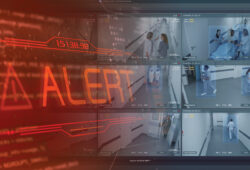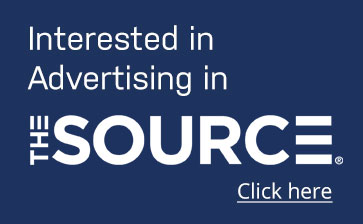Mitigating emergencies & threats with technology
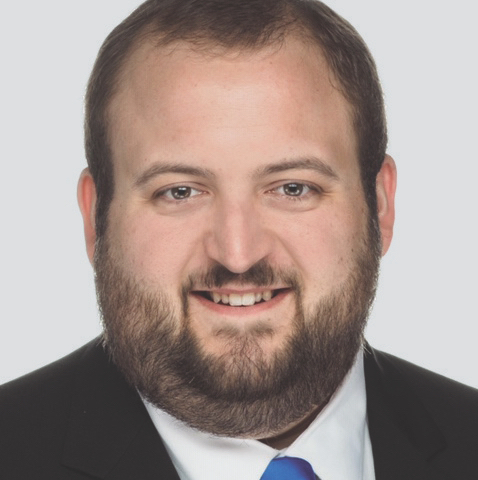
No two emergencies are the same, and whether something rises to the level of a health system disaster depends on several factors. A bus rollover on the interstate injuring 50 people is not a disaster for a hospital with a Level II trauma center and 400 beds. “That hospital is fully equipped to handle the patients on its own,” says Jake Marshall, MPS, CEM, FF/NRP, Senior Director of HCA Healthcare’s Enterprise Preparedness and Emergency Operations (EPEO). But that same accident in a rural area with a community hospital or freestanding emergency room? That’s a disaster. “It’s a different incident for them even if it’s the same emergency.”
Disasters and other emergencies rely on technology and tools for mitigation. They depend on real-time information which can affect clinical care, available supplies, staffing and equipment.
Tools & technologies that make a difference
Situational awareness at all times is vital, and it can be preventive and predictive. “That’s where a lot of our tools and technologies focus,” explains Marshall. The tools used by HCA Healthcare include private meteorological services that advise on weather threats, including wildfires. For example, StormGeo is a global firm with its American headquarters in Houston. StormGeo provides access to an expansive weather portal that any HCA Healthcare command center can access. It can pinpoint wind speeds and inform the potential impact on the population. “It’s city-block by city-block-detailed forecasting,” Marshall says. “It’s really remarkable when you consider the power that the tool gives our facilities to prepare for different crises.”
General situational awareness
Dataminr is used for general situational awareness. It is an AI-powered platform that actively scans around 500,000 public sources of information globally. That includes social media sites, news organizations, police, fire and emergency medical dispatch systems. It provides near real-time emergency incident control alerts. “There have been numerous times in active shooter situations where we have been given an alert of a potential situation in the community simultaneously or before the local 911 services are dispatched,” Marshall says. “That’s how powerful the information is within this platform.” It allows us to ensure our facilities have the resources and staffing in place to handle a crisis situation.
General incident management
CodeReady EOC is used as a general incident management platform. Any facility that experiences an incident causing a clinical or business disruption on site enters the incident in the platform. It triggers a cascading alert depending on the incident type and severity. And, if needed, it can ascend to the regional or enterprise level. “We’re getting near real-time alerts of a situation, so we can get on a company conference call with the relevant stakeholders,” explains Marshall.
Awareness & business continuity
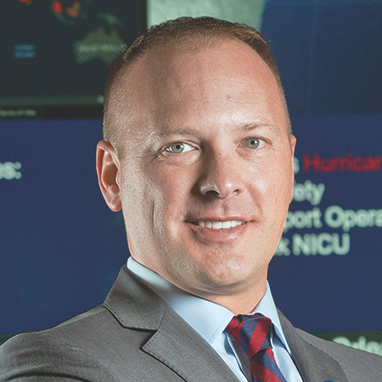
Vice President of HCA Healthcare’s EPEO, Michael Wargo, RN, BSN, MBA, PHRN, CMTE, began building the organization’s program in 2016, with Marshall joining the next year. By 2020, the enterprise had responded to at least 900 incidents, ranging from wildfires to active shooters to loss of power. An incident is defined as an event with the potential to disrupt the clinical or business functioning. Enterprise preparedness and emergency operation (EPEO) focuses on the organization’s core business: healthcare and its delivery. “Without business continuity, we can’t deliver healthcare. We need to ensure the infrastructure is in place—the supplies, equipment, buildings and everything it takes to do our job.”
The program is built to parallel the levels of government: The EPEO is like the federal government; the division level mirrors the state government, with multiple jurisdictions, markets and regional areas; and the local facilities are where healthcare is ultimately delivered. Wargo characterizes EPEO’s approach as an “all hazards” or “universal hazards” model—a standardized framework for how they manage and respond to any crisis, with common priorities of safety, infrastructure, operations and mission.
Whether a major crisis or lower-level stressor, the EPEO program maintains situational awareness. Team members constantly need to know that their programming, facilities, divisions and company are in a state of readiness. “We are prepared with the immediate ability to respond to any crisis,” Wargo explains. The tools help provide this situational awareness and context of how events can affect them globally.
Domestic & global threats
Domestically, EPEO monitors wildfires in the west, hurricanes in the south and mass casualty events that can happen anywhere. Even isolated events at a local or market level can become complex, requiring the enterprise to triage resources from other areas and deploy them. “And that’s where we truly use this technology to have situational awareness to assess if we are ready. From identifying the threats and what the current impact is to managing the threats and needs across the enterprise—the technology helps inform leadership decisions and operations companywide,” shares Wargo.
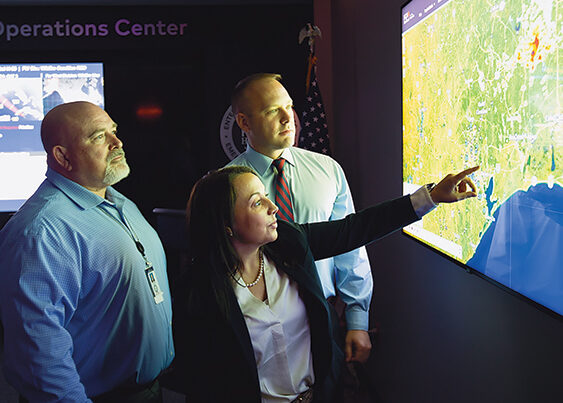
Looking at global threat intelligence, “You wouldn’t think a healthcare organization would have that type of perspective, but we’re forced to as a multinational company,” says Marshall.” There are more than 2,300 sites of care, including freestanding emergency departments and urgent care clinics. “When you look at exposure to threats and hazards across the company, we need the situational awareness to make sure we’re doing the best we can to protect all of our assets and people,” he adds.
“A lot of other American healthcare systems are regionally-based,” says Marshall. They may need to respond to hurricanes, wildfires or blizzards, but maybe just one type. “We see it all,” he adds, “approximately 80 types of emergency threats across the enterprise.”
Disasters to low-level stressors
HCA Healthcare’s most common incidences are severe weather responses. “As the geographic footprint exists today, roughly 50% to 60% of our physical assets are in hurricane risk or impact zones,” says Marshall. “That creates a very large seasonal risk for us to program against to make sure that we’re ready every year.”
They also prepare for utility emergencies, separate from adverse weather. “As an operator, we are a valuable and critical resource for the community. We’re relied upon as a community resource to continue to function. Our hospitals need a continuous source of power, water, natural gas, etc.,” Marshall explains. A utility loss for a prolonged period of time creates additional challenges for providing clinical care.
The EPEO team also watches out for IT and telecommunications failures, separate from utility emergencies. “It’s essential in healthcare, especially in an integrated system reliant on technology, to give our patients the best care possible,” Marshall says. Satellite phones, back-up data and internet capabilities provide redundancy. Motorola has been engaged to create duplicate communications pathways, along with FirstNet, a government telecommunications system powered by AT&T. HealthTrust provides contracts for these services, and they are deployed across the HCA Healthcare enterprise.
Lower-level incidents may impact clinical or business operations at a single facility but not shut it down. There could be a mass casualty that affects the facility for a short time, and the enterprise-level EPEO is aware of it, but without an urgent need to get involved. An isolated utility problem may cut the internet feed, but there is backup available. These issues are managed through local resources.
The EPEO triages any incident to assign the right level of resources. “We try to triage at the lowest level possible,” Marshall explains, as the on-site staff has greater expertise for their area and needs.
Each facility may have a different level of personnel strategically dedicated to emergency management based on their scale. A hospital with 300 or more acute beds may have a full-time emergency management employee. Community hospitals may have a shared role within the hospital’s Command Center, with the Director of Facility Management sharing responsibilities with the Emergency Department Director. “At every hospital, there is a responsible executive accountable for making sure the hospital is fully compliant with our standards,” shares Marshall.
While local hospitals ensure delivery of patient care and support the community, the enterprise-level EPEO takes a 30,000-foot view of what the hospitals need and how to provide required resources—whether people, supplies or equipment. As the local hospital deals with an incident, the EPEO thinks through the greater impact. “We have optimism in mind but take a pessimistic approach,” says Marshall. Facilities look at the next 12 hours, the Division Command Centers look at the next 12 days, the enterprise looks at the next 12 weeks, and the EPEO can be managing several crises or incidents at the same time.
Threats are increasing
The number and severity of threats is increasing for hospital systems, Wargo says.
Of the 10 costliest disasters in the last 20 years, Marshall says that “HCA Healthcare was impacted by each of those. We’re responding to a greater number of incidences, and they’re more severe.” There are an increased number and intensity of storms, along with more wildfires. “We see a lot of people who live on the seaboards being impacted.” Wargo explains.
Hospitals used to just take care of people when they were sick. Now they are more of a public utility, expected to be operational and ready for any public crisis. “Society is holding our organizations responsible to handle crises in the community,” Wargo adds. In the past when something bad happened, the community appreciated when the health system took care of them. Now there’s a feeling that it’s the health systems’ social responsibility to do so, and these systems need to be better prepared to respond.
The EPEO takes that role, and uses technology to mitigate crises and low-level threats every day, enhancing the ability to respond. These tools are used to help identify and manage risks. “It’s important to prevent a broader organizational risk by having situational awareness of what’s going on in the community. We need to understand how ready our facilities are. And, we have to have an organized approach to deal with any type of event that might impact patient care or the operations of the public health system. If we don’t do that, it’s a risk to the organization and to the profession,” Wargo says.
Visit the HealthTrust Huddle on the Member Portal and tell us how your organization is using technology to mitigate crises and low-level threats. Or, for help in this area, contact HealthTrust Advisory Services at solutions@healthtrustpg.com
Share Email Disaster & Emergency Preparedness, Q3 2023
